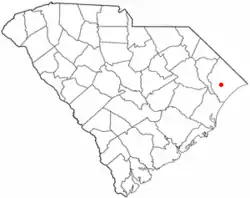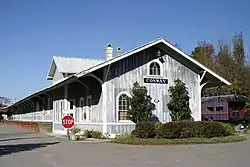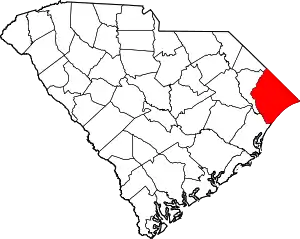Conway, South Carolina
Conway is a city in Horry County, South Carolina. The population was 24,849 at the 2020 census,[8] up from 17,103 in the 2010 census.[9] It is the county seat of Horry County[10] and is part of the Myrtle Beach metropolitan area. It is the home of Coastal Carolina University.
Conway | |
|---|---|
.jpg.webp) | |
 Flag  Seal  Logo | |
| Nickname: Historic Rivertown[1] | |
 Location of Conway in South Carolina | |
| Coordinates: 33°50′17″N 79°3′22″W | |
| Country | United States |
| State | South Carolina |
| County | Horry |
| Founded | 1732 |
| Named for | General Robert Conway[2] |
| Government | |
| • Mayor | Barbara Blain Bellamy[3] |
| Area | |
| • Total | 25.41 sq mi (65.80 km2) |
| • Land | 24.51 sq mi (63.47 km2) |
| • Water | 0.90 sq mi (2.33 km2) |
| Elevation | 33 ft (10 m) |
| Population | |
| • Total | 24,849 |
| • Estimate (2022) | 27,346 |
| • Density | 1,013.96/sq mi (391.49/km2) |
| Time zone | UTC−5 (EST) |
| • Summer (DST) | UTC−4 (EDT) |
| ZIP codes | 29526-29528 |
| Area code(s) | 843, 854 |
| FIPS code | 45-16405[6] |
| GNIS feature ID | 1247370[7] |
| Website | www |
Numerous buildings and structures located in Conway are on the National Register of Historic Places. Among these is the City Hall building, designed by Robert Mills, architect of the Washington Monument. Since the completion of the Main Street USA project in the 1980s, Conway's downtown has been revitalized with shops and bistros. Highlighting the renovation of the downtown area is the Riverwalk, an area of restaurants which follows a stretch of the Waccamaw River that winds through Conway.[11][12]
History
Conway is one of the oldest towns in South Carolina. Early English colonists named the village "Kings Town" but soon changed it to "Kingston". The town was founded in 1732 as part of Royal Governor Robert Johnson's Township Scheme. It was laid out on a bluff overlooking the Waccamaw River in what is now known as Horry County.
For three decades, from the 1730s to the 1750s, King George II was very popular in the area. The King's birthday was one of the most widely celebrated holidays during that time. However, his successor King George III quickly grew unpopular with the townspeople. By the 1770s, the region of South Carolina in which Kingston was located in was overwhelmingly English, though there were also small numbers of Huguenots and Scots-Irish people. English-Americans in Kingston were very sympathetic to rebels in Charleston over the issue of taxation without representation. When the Royal Governor Lord William Campbell fled Charleston, the people of Kingston celebrated.[13]
Many area residents fought in the American Revolution, and small engagements were fought near Kingston at Bear Bluff and at Black Lake. Francis Marion, who was known as the "Swamp Fox", had an encampment near Kingston just across the Waccamaw River.[14] The areas of Kingston and Charles Town were communities with a higher population of Tories than many other Colonial American towns during the Revolutionary War era.[15]
Horry County was created in 1801, and its courthouse was established in Kingston. The name "Kingston" was later changed to "Conwayborough", to honor local hero General Robert Conway. In 1883, the South Carolina General Assembly changed the name of the town to "Conway".
Geography
Conway is situated on the South Carolina Coastal Plain on the western banks of the Waccamaw River, and is approximately 14 miles (23 km) from the Atlantic Ocean. U.S. Route 701, U.S. Route 501, and U.S. Route 378 pass through Conway.
According to the United States Census Bureau, the city has a total area of 22.8 square miles (59.0 km2), of which 21.9 square miles (56.8 km2) are land and 0.85 square miles (2.2 km2), or 3.69%, are water.[9] The downtown is sited on the west bank of the Waccamaw River where it is joined by a creek called Kingston Lake. The Waccamaw flows south to the Pee Dee River and ultimately Winyah Bay at Georgetown.
Climate
Conway has a humid subtropical climate, with mild winters and hot, humid summers. The local climate allows plants like kale to survive deep into the winter months, despite the lower amount of light. 60's and 70's weather are not rare during the months of December, January, and February. Spring starts in March, as usual for the climatic schedule of the area. Comparable major metro areas for this climate of Conway include Montgomery, Alabama and Jackson, Mississippi.
| Climate data for Conway, South Carolina (1991–2020 normals, extremes 1893–2014) | |||||||||||||
|---|---|---|---|---|---|---|---|---|---|---|---|---|---|
| Month | Jan | Feb | Mar | Apr | May | Jun | Jul | Aug | Sep | Oct | Nov | Dec | Year |
| Record high °F (°C) | 83 (28) |
85 (29) |
96 (36) |
96 (36) |
101 (38) |
106 (41) |
105 (41) |
106 (41) |
105 (41) |
98 (37) |
89 (32) |
84 (29) |
106 (41) |
| Mean maximum °F (°C) | 74.6 (23.7) |
77.9 (25.5) |
82.9 (28.3) |
87.9 (31.1) |
93.0 (33.9) |
97.2 (36.2) |
98.7 (37.1) |
97.6 (36.4) |
93.5 (34.2) |
87.9 (31.1) |
81.4 (27.4) |
76.6 (24.8) |
100.1 (37.8) |
| Average high °F (°C) | 58.1 (14.5) |
60.6 (15.9) |
68.0 (20.0) |
75.8 (24.3) |
82.6 (28.1) |
87.7 (30.9) |
90.8 (32.7) |
89.1 (31.7) |
84.8 (29.3) |
76.9 (24.9) |
68.2 (20.1) |
60.6 (15.9) |
75.3 (24.1) |
| Daily mean °F (°C) | 46.7 (8.2) |
49.4 (9.7) |
55.8 (13.2) |
63.8 (17.7) |
71.6 (22.0) |
78.2 (25.7) |
81.6 (27.6) |
80.2 (26.8) |
75.4 (24.1) |
65.9 (18.8) |
56.1 (13.4) |
49.6 (9.8) |
64.5 (18.1) |
| Average low °F (°C) | 35.2 (1.8) |
38.1 (3.4) |
43.6 (6.4) |
51.9 (11.1) |
60.6 (15.9) |
68.7 (20.4) |
72.4 (22.4) |
71.2 (21.8) |
66.0 (18.9) |
54.8 (12.7) |
44.1 (6.7) |
38.6 (3.7) |
53.8 (12.1) |
| Mean minimum °F (°C) | 19.9 (−6.7) |
24.6 (−4.1) |
29.5 (−1.4) |
37.5 (3.1) |
46.8 (8.2) |
58.4 (14.7) |
65.3 (18.5) |
63.1 (17.3) |
52.8 (11.6) |
39.5 (4.2) |
31.1 (−0.5) |
22.3 (−5.4) |
17.6 (−8.0) |
| Record low °F (°C) | 4 (−16) |
11 (−12) |
12 (−11) |
22 (−6) |
34 (1) |
42 (6) |
51 (11) |
51 (11) |
41 (5) |
22 (−6) |
15 (−9) |
6 (−14) |
4 (−16) |
| Average precipitation inches (mm) | 4.28 (109) |
3.57 (91) |
3.76 (96) |
3.16 (80) |
3.33 (85) |
5.34 (136) |
6.89 (175) |
7.81 (198) |
6.00 (152) |
3.83 (97) |
3.21 (82) |
4.03 (102) |
55.21 (1,402) |
| Average precipitation days (≥ 0.01 in) | 9.4 | 7.6 | 8.0 | 6.9 | 8.1 | 10.6 | 10.7 | 10.9 | 8.1 | 6.4 | 6.6 | 8.0 | 101.3 |
| Source: NOAA (mean maxima/minima 1981–2010)[16][17] | |||||||||||||
Demographics
| Census | Pop. | Note | %± |
|---|---|---|---|
| 1860 | 476 | — | |
| 1870 | 696 | 46.2% | |
| 1880 | 575 | −17.4% | |
| 1890 | 677 | 17.7% | |
| 1900 | 705 | 4.1% | |
| 1910 | 1,228 | 74.2% | |
| 1920 | 1,969 | 60.3% | |
| 1930 | 3,011 | 52.9% | |
| 1940 | 5,066 | 68.2% | |
| 1950 | 6,073 | 19.9% | |
| 1960 | 8,563 | 41.0% | |
| 1970 | 8,151 | −4.8% | |
| 1980 | 10,240 | 25.6% | |
| 1990 | 9,819 | −4.1% | |
| 2000 | 11,788 | 20.1% | |
| 2010 | 17,103 | 45.1% | |
| 2020 | 24,849 | 45.3% | |
| 2022 (est.) | 27,346 | [8] | 10.0% |
| U.S. Decennial Census[18][5] | |||
2020 census
| Race | Num. | Perc. |
|---|---|---|
| White (non-Hispanic) | 15,042 | 60.53% |
| Black or African American (non-Hispanic) | 7,272 | 29.26% |
| Native American | 77 | 0.31% |
| Asian | 292 | 1.18% |
| Pacific Islander | 22 | 0.09% |
| Other/Mixed | 968 | 3.9% |
| Hispanic or Latino | 1,176 | 4.73% |
As of the 2020 United States census, there were 24,849 people, 7,921 households, and 4,881 families residing in the city.
2000 census
As of the census[6] of 2000, there were 11,788 people, 4,259 households, and 2,942 families residing in the city. The population density was 927.8 inhabitants per square mile (358.2/km2). There were 4,783 housing units at an average density of 376.5 per square mile (145.4/km2). The racial makeup of the city was 55.82% White, 41.85% African American, 0.21% Native American, 0.74% Asian, 0.03% Pacific Islander, 0.64% from other races, and 0.72% from two or more races. Hispanic or Latino of any race were 1.87% of the population.
There were 4,259 households, out of which 32.8% had children under the age of 18 living with them, 42.3% were married couples living together, 23.3% had a female householder with no husband present, and 30.9% were non-families. 26.7% of all households were made up of individuals, and 9.9% had someone living alone who was 65 years of age or older. The average household size was 2.52 and the average family size was 3.02.
In the city, the population was spread out, with 25.1% under the age of 18, 15.8% from 18 to 24, 25.3% from 25 to 44, 20.2% from 45 to 64, and 13.6% who were 65 years of age or older. The median age was 33 years. For every 100 females, there were 83.2 males. For every 100 females age 18 and over, there were 75 males.
The median income for a household in the city was $32,155, and the median income for a family was $39,189. Males had a median income of $26,720 versus $21,310 for females. The per capita income for the city was $16,611. About 15.9% of families and 20.2% of the population were below the poverty line, including 32.9% of those under age 18 and 16.0% of those age 65 or over.
Economy
Employers located in the Conway area include:
- New South Companies, Inc. (a subsidiary of Canfor)
- Vulcan Materials Company
- AVX Corporation
Grainger Generating Station was a coal-fired power plant operated by Santee Cooper. It generated electricity from 1966 until its retirement in 2012.[20]
Arts and culture

Conway is the home of Kimbel Library and the Rebecca Randall Bryan Art Gallery at Coastal Carolina University. The gallery houses differing exhibits throughout the year.[21]
Sports
HTC Center is a 3,370-seat multi-purpose arena located on the campus of Coastal Carolina University in Conway. It is home to the university's men's and women's basketball teams, and the women's volleyball teams. It replaced Kimbel Arena for this purpose.
Government

The city is run by an elected mayor-council government system with one mayor and 6 council members.[22] The current mayor is Barbara Blain-Bellamy who was first sworn in on January 4, 2016 and re-elected on January 6, 2020.[23] The 6 council members are Amanda Butler, Autry Benton, Beth Helms, William Goldfinch IV, Justin Jordan, and Larry White. Council members are elected at large and serve staggered four year terms. Each member, including the mayor, has one vote in city matters. Council members meet twice a month; on the first and third Monday at 4:00 p.m. at Conway Council Chambers.[24]
Education
Most of the county is served by a single public school system, Horry County Schools. Private schools include Conway Christian School.
Conway is home to two major institutes of higher learning, Coastal Carolina University and Horry-Georgetown Technical College. It is also home to a branch of Webster University, an MBA graduate school, and North American Institute of Aviation (NAIA), a flight school.
Conway has a public library, a branch of the Horry County Memorial Library.[25]
Media
- The Chanticleer News (the student newspaper of Coastal Carolina University)
- Rivertown Radio
- Horry Independent
Infrastructure
Transportation

Air
Conway is home to the Conway–Horry County Airport (HYW),[26] a small airport located 4 miles (6 km) west of town, along US 378.
Bus
A large part of Horry County is served by the Coast Regional Transit Authority (RTA),[27] formerly known as the Waccamaw Regional Transit Authority and as Lymo. The primary station and offices are located in downtown Conway, near the historic district.
Railroads
R. J. Corman Railroad's Carolina Line is a short-line railroad which serves parts of North and South Carolina. Conway is located on the railroad's Chadbourn, NC–Myrtle Beach, SC branch. The historic Conway railroad depot is located along this branch, although the depot is now an office building.
Notable people
- Bryant Barnhill, racing driver
- Bryan Edwards, American football player
- William Gibson, author, credited as the father of the cyberpunk genre of science fiction
- Junior Hemingway, former Michigan Wolverine wide receiver
- Grant Holmes, professional baseball pitcher
- Edgar L. McGowan, former commissioner of the South Carolina Department of Labor[28]
- Kristy McPherson, golfer on the LPGA Tour
- Allen Patrick, Oklahoma Sooners running back and NFL player
- Hunter Renfrow, American football player
- Sheri Reynolds, author and associate professor of Southern literature at Old Dominion University
- Nick Shalosky, first openly gay elected official in South Carolina
- Margot Stilley, actress and writer
- Duley Trucc, musical artist
See also
- List of municipalities in South Carolina
- Conway is home to the Waccamaw Indian People, the original inhabitants of the area, who lived along the Waccamaw River.[29]
References
- "City of Conway, SC". City of Conway. Retrieved January 24, 2018.
- "A Brief History". www.cityofconway.com. Retrieved December 7, 2022.
- "City Council". www.cityofconway.com.
- "ArcGIS REST Services Directory". United States Census Bureau. Retrieved October 15, 2022.
- "Census Population API". United States Census Bureau. Retrieved October 15, 2022.
- "U.S. Census website". United States Census Bureau. Retrieved January 31, 2008.
- "US Board on Geographic Names". United States Geological Survey. October 25, 2007. Retrieved January 31, 2008.
- "U.S. Census Bureau QuickFacts: Conway city, South Carolina". United States Census Bureau. Retrieved September 14, 2022.
- "Geographic Identifiers: 2010 Census Summary File 1 (G001): Conway city, South Carolina". American Factfinder. U.S. Census Bureau. Archived from the original on February 13, 2020. Retrieved January 24, 2018.
- "Find a County". National Association of Counties. Archived from the original on May 31, 2011. Retrieved June 7, 2011.
- "Conway Downtown Alive - Downtown Conway, South Carolina". conwayalive.com. Retrieved November 6, 2022.
- "Conway Riverwalk". www.sctrails.net. Retrieved November 6, 2022.
- The South Carolina Encyclopedia by Walter B. Edgar, 2006 - pg. 222
- "Conway, South Carolina | Advisory Council on Historic Preservation".
- "Estate Confiscation Lists". sc_tories.tripod.com. Retrieved April 21, 2018.
- "NOWData – NOAA Online Weather Data". National Oceanic and Atmospheric Administration. Retrieved October 10, 2023.
- "Summary of Monthly Normals 1991–2020". National Oceanic and Atmospheric Administration. Retrieved October 10, 2023.
- "Census of Population and Housing". Census.gov. Retrieved June 4, 2015.
- "Explore Census Data". data.census.gov. Retrieved December 15, 2021.
- "Santee Cooper board authorizes retirements of Jefferies and Grainger generating units". The Summerville Journal Scene. October 19, 2012. Retrieved January 2, 2018.
- "Bryan Art Gallery". Coastal Carolina University. Retrieved January 24, 2018.
- "City Council". www.cityofconway.com. Retrieved October 11, 2023.
- "Welcome to City of Conway, SC". www.cityofconway.com. Retrieved October 11, 2023.
- "City Council". www.cityofconway.com. Retrieved October 11, 2023.
- "Locations & Hours". Horry County Memorial Library. Retrieved October 1, 2023.
- AirNav: KHYW - Conway-Horry County Airport
- The Coast RTA
- "Edgar McGowan, former state Labor Department director, dies".
- Rohrback, Harold (February 2013). "Stewards Of The Land". Grand Strand Magazine. Retrieved May 22, 2022.
External links
 Geographic data related to Conway, South Carolina at OpenStreetMap
Geographic data related to Conway, South Carolina at OpenStreetMap- Official website
